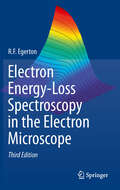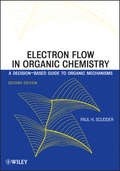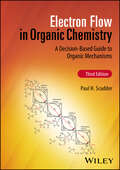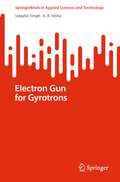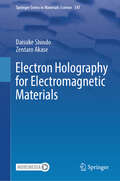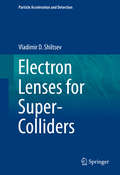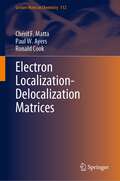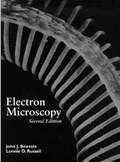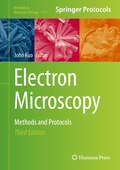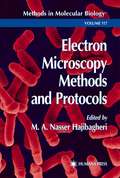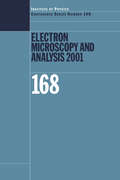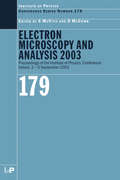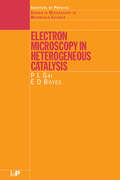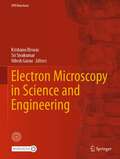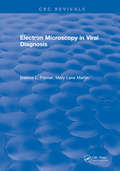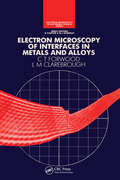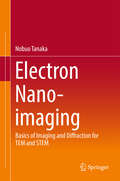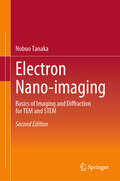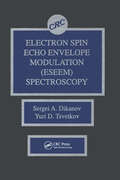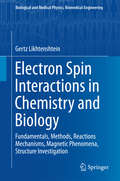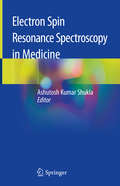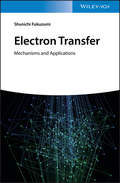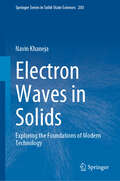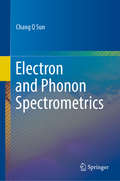- Table View
- List View
Electron Energy-Loss Spectroscopy in the Electron Microscope
by R. F. EgertonWithin the last 30 years, electron energy-loss spectroscopy (EELS) has become a standard analytical technique used in the transmission electron microscope to extract chemical and structural information down to the atomic level. In two previous editions, Electron Energy-Loss Spectroscopy in the Electron Microscope has become the standard reference guide to the instrumentation, physics and procedures involved, and the kind of results obtainable. Within the last few years, the commercial availability of lens-aberration correctors and electron-beam monochromators has further increased the spatial and energy resolution of EELS. This thoroughly updated and revised Third Edition incorporates these new developments, as well as advances in electron-scattering theory, spectral and image processing, and recent applications in fields such as nanotechnology. The appendices now contain a listing of inelastic mean free paths and a description of more than 20 MATLAB programs for calculating EELS data.
Electron Flow in Organic Chemistry
by Paul H. ScudderSets forth the analytical tools needed to solve key problems in organic chemistryWith its acclaimed decision-based approach, Electron Flow in Organic Chemistry enables readers to develop the essential critical thinking skills needed to analyze and solve problems in organic chemistry, from the simple to complex. The author breaks down common mechanistic organic processes into their basic units to explain the core electron flow pathways that underlie these processes. Moreover, the text stresses the use of analytical tools such as flow charts, correlation matrices, and energy surfaces to enable readers new to organic chemistry to grasp the fundamentals at a much deeper level.This Second Edition of Electron Flow in Organic Chemistry has been thoroughly revised, reorganized, and streamlined in response to feedback from both students and instructors. Readers will find more flowcharts, correlation matrices, and algorithms that illustrate key decision-making processes step by step. There are new examples from the field of biochemistry, making the text more relevant to a broader range of readers in chemistry, biology, and medicine. This edition also offers three new chapters:Proton transfer and the principles of stabilityImportant reaction archetypesQualitative molecular orbital theory and pericyclic reactionsThe text's appendix features a variety of helpful tools, including a general bibliography, quick-reference charts and tables, pathway summaries, and a major decisions guide.With its emphasis on logical processes rather than memorization to solve mechanistic problems, this text gives readers a solid foundation to approach and solve any problem in organic chemistry.
Electron Flow in Organic Chemistry: A Decision-Based Guide to Organic Mechanisms
by Paul H. ScudderElectron Flow in Organic Chemistry Teaches students to solve problems in Organic Chemistry using methods of analysis that are valuable and portable to other fields Electron Flow in Organic Chemistry provides a unique decision-based approach that develops a chemical intuition based on a crosschecked analysis process. Assuming only a general background in chemistry, this acclaimed textbook teaches students how to write reasonable reaction mechanisms and use analytical tools to solve both simple and complex problems in organic chemistry. As in previous editions, the author breaks down challenging organic mechanisms into a limited number of core elemental mechanistic processes, the electron flow pathways, to explain all organic reactions—using flow charts as decision maps, energy surfaces as problem space maps, and correlation matrices to display all possible interactions. The third edition features entirely new chapters on crosschecking chemical reactions through good mechanistic thinking and solving spectral analysis problems using organic structure elucidation strategies. This edition also includes more biochemical reaction mechanism examples, additional exercises with answers, expanded discussion of how general chemistry concepts can show that structure determines reactivity, and new appendix covering transition metal organometallics. Emphasizing critical thinking rather than memorization to solve mechanistic problems, this popular textbook: Features new and expanded material throughout, including more flowcharts, correlation matrices, energy surfaces, and algorithms that illustrate key decision-making processes Provides examples from the field of biochemistry of relevance to students in chemistry, biology, and medicine Incorporates principles from computer science and artificial intelligence to teach decision-making processes Contains a general bibliography, quick-reference charts and tables, pathway summaries, a major decisions guide, and other helpful tools Offers material for instructors including a solutions manual, supplemental exercises with detailed answers for each chapter usable as an exam file, and additional online resources Electron Flow in Organic Chemistry: A Decision-Based Guide to Organic Mechanisms, Third Edition, is the perfect primary textbook for advanced undergraduate or beginning graduate courses in organic reaction mechanisms, and an excellent supplement for graduate courses in physical organic chemistry, enzymatic reaction mechanisms, and biochemistry.
Electron Gun for Gyrotrons (SpringerBriefs in Applied Sciences and Technology)
by Udaybir Singh A. K. SinhaThis book highlights the emission, transmission, and launching of an electron beam. It presents an overview and recent advances in order to enhance knowledge in the field of gyrotron in general and electron gun in particular. The book is presented in seven chapters starting with the introduction and ending with future possible directions in the field of electron beams and gyrotrons.
Electron Holography for Electromagnetic Materials (Springer Series in Materials Science #347)
by Daisuke Shindo Zentaro AkaseThis book discusses the direct imaging of electric and magnetic fields of various functional materials using electron holography, providing indispensable information for understanding their electromagnetic properties. In order to clearly demonstrate the principles of this cutting-edge technology, easy-to-understand explanations are accompanied by numerous illustrations and figures throughout the book. The book highlights the dynamic nature of electromagnetic fields in novel materials, as revealed by changing temperature, or applying electric current and magnetic fields. Furthermore, it showcases, as a new development of the technique, the direct observation of accumulation and collective motion of electrons around charged insulators. Clear experimental data on electromagnetic fields and the motions of electrons help the reader understand their importance in materials science and fundamental physics. Seeing is believing!
Electron Lenses for Super-Colliders
by Vladimir D. ShiltsevThis book provides a comprehensive overview of the operating principles and technology of electron lenses in supercolliders. Electron lenses are a novel instrument for high energy particle accelerators, particularly for the energy-frontier superconducting hadron colliders, including the Tevatron, RHIC, LHC and future very large hadron colliders. After reviewing the issues surrounding beam dynamics in supercolliders, the book offers an introduction to the electron lens method and its application. Further chapters describe the technology behind the electron lenses which have recently been proposed, built and employed for compensation of beam-beam effects and for collimation of high-energy high-intensity beams, for compensation of space-charge effects and several other applications in accelerators. The book will be an invaluable resource for those involved in the design, construction and operation of the next generation of hadron colliders.
Electron Localization-Delocalization Matrices (Lecture Notes in Chemistry #112)
by Chérif F. Matta Ronald Cook Paul W. AyersThis book builds bridges between two yet separated branches of theoretical and mathematical chemistry: Chemical Graph Theory and Electronic Structure Calculations. Although either of the fields have developed their own techniques, problems, methods, and favorite benchmark cases independent from each other, the authors have managed to bring them together by using the localization-delocalization matrix (LDM). The LDM is a novel molecular descriptor that fingerprints a molecule by condensing the complicated electronic information in one, mathematically manageable, object. In this book, the authors introduce the readers to modeling techniques based on LDMs. Their technique offers a high accuracy as well as robust predictive power, often dramatically surpassing the potential of either of the constituting methods on their own. In addition to the comprehensive and accessible introduction to this new field of theoretical chemistry, the authors offer their self-developed software free to download, so that readers can try running their own simulations. The described methods are very general and can easily be implemented for calculating various properties and parameters such as mosquito repelling activity, ionic liquid properties, local aromaticity of ring molecules, log P's, pKa's, LD50, corrosion inhibition activities, and Lewis acidities and basicities – to only name a few. The free downloadable software helps readers automate the analysis of the matrices described in this book and hence facilitates application of the described methodology.
Electron Microscopy
by John J. Bozzola Lonnie D. RussellElectron Microscopy covers all of the important aspects of electron microscopy for biologists, including theory of scanning and transmission, specimen preparation, digital imaging and image analysis, laboratory safety and interpretation of images. The text also contains a complete atlas of ultrastructure. The text assumes minimal experience in physics and mathematics and is written so that readers will achieve a basic understanding of underlying principles so that these can be applied in a real laboratory setting.
Electron Microscopy
by John KuoThis book presents the newest technology in electron microscopy. It comprises two major areas of electron microscopy - transmission electron microscopy (TEM) and scanning electron microscopy (SEM). The volume provides clear, concise instructions on processing biological specimens and includes discussion on the underlying principles of the majority of the processes presented. A notes section enables efficient adaptation and troubleshooting of protocols.
Electron Microscopy Methods and Protocols
by M. A. HajibagheriHands-on experts describe in detail the key electron microscopy techniques used for examining cells, tissue, biological macromolecules, molecular structure, and their interactions. With emphasis on cryotechniques for quantitative biological X-ray microanalysis, the book also includes those methods that use antibodies to locate proteins within cells and that prepare and analyze nucleic acids, proteins, and protein-nucleic acid complexes. Numerous immunogold labeling techniques for precise ultrastructural localization, distribution, and quantitation of macromolecules in cryofixed or chemically-fixed cells are described in sufficient detail to provide practical insight into their advantages and limitations. Electron Microscopy Methods and Protocols offers both newcomers and established researchers across experimental biology and medicine wanting to expand their repertoire a gold-standard laboratory manual of cutting-edge electron microscopy techniques-each optimized for reproducibility and robust results-today's gold-standard laboratory manual.
Electron Microscopy and Analysis 1997, Proceedings of the Institute of Physics Electron Microscopy and Analysis Group Conference, University of Cambridge, 2-5 September 1997
by John M. RodenburgElectron Microscopy and Analysis 1997 celebrates the centenary anniversary of the discovery of the electron by J.J. Thomson in Cambridge and the fiftieth anniversary of this distinguished Institute group. The book includes papers on the early history of electron microscopy (from P. Hawkes), the development of the scanning electron microscope at Cambridge (from K. Smith), electron energy loss spectroscopy (from L.M. Brown), imaging methods (from J. Spence), and the future of electron microscopy (from C. Humphreys). Covering a wide range of applications of advanced techniques, it discusses electron imaging, electron energy-loss and x-ray analysis, and scanning probe and electron beam microscopies. This volume is a handy reference for professionals using microscopes in all areas of physics, materials science, metallurgy, and surface science to gain an overview of developments in our understanding of materials microstructure and of advances in microscope interrogation techniques.
Electron Microscopy and Analysis 2001 (Institute of Physics Conference Series)
by M Aindow C J KielyElectron microscopy is now a mainstay characterization tool for solid state physicists and chemists as well as materials scientists. Electron Microscopy and Analysis 2001 presents a useful snapshot of the latest developments in instrumentation, analysis techniques, and applications of electron and scanning probe microscopies. The book is ideal for
Electron Microscopy and Analysis 2003: Proceedings of the Institute of Physics Electron Microscopy and Analysis Group Conference, 3-5 September 2003
by David McComb Stephen MeVitieElectron microscopy is now a mainstay characterization tool for solid state physicists and chemists as well as materials scientists. Containing the proceedings from the Electron Microscopy and Analysis Group (EMAG) conference in September 2003, this volume covers current developments in the field, primarily in the UK. These conferences are biennial
Electron Microscopy in Heterogeneous Catalysis (Series in Microscopy in Materials Science)
by P.L Gai E.D BoyesCatalysis is one of the most important technologies in the industrial world, controlling more than 90% of industrial chemical processes and essential for large-scale production of plastics and fuel. Exploring the most common type of catalysis used in industry, Electron Microscopy in Heterogeneous Catalysis provides a coherent account of heterogeneo
Electron Microscopy in Science and Engineering (IITK Directions #6)
by Krishanu Biswas Sri Sivakumar Nilesh GuraoThis issue of Direction focuses on the rapid proliferation of electron microscopy (EM) for scientific as well as technological research. The content written by leading experts is intended to provide the capabilities of EM facilities, set at Indian Institute of Technology (IIT) Kanpur to solve various problems and caters to the needs of both internal and external users. The book provides a detailed and comprehensive viewpoint of the basic features and advanced capabilities of EM facilities to the scientific community. A large number of electron microscopes have been installed and utilized by researchers across various engineering and science departments; hence, this volume provides both breadth as well as depth of various EM facilities available at the institute.
Electron Microscopy in Viral Diagnosis
by Erskine L. PalmerThis text on electron microscopy in viral diagnosis is an invaluable reference investigators interested in the detection of viruses or viral subcomponents in liquid preparations or in thin sectioned cells. It contains an extensive collection of negative stain, thin section, and immunolabelled electron micrographs useful for reference viral diagnosis. The salient features of the replication of many virus families are presented in schematic form and all viruses now known to cause disease in humans, including the recently recognized human retroviruses, are described in separate chapter.
Electron Microscopy of Interfaces in Metals and Alloys
by L.M ClarebroughElectron Microscopy of Interfaces in Metals and Alloys examines the structure of interfaces in metals and alloys using transmission electron microscopy. The book presents quantitative methods of analysis and reviews the most significant work on interface structure over the last 20 years. It provides the first book description of the methods used for quantitative identification of Burgers vectors of interfacial dislocations, including the geometric analysis of periodicities in interface structure and the comparison of experimental and theoretical electron micrographs. The book explores low- and high-angle grain boundaries and interphase interfaces between neighboring grains, emphasizing interfacial dislocations and rigid-body displacements to the structure and properties of interfaces. It also analyzes the use of two-beam images and diffraction patterns for analysis and studies n-beam lattice imaging. The book includes numerous worked examples of the analysis of the structure of grain boundaries and interphase interfaces, which are particularly useful to those who need to consider the nature of intercrystalline interfaces.
Electron Nano-Imaging
by Nobuo TanakaIn this book, the bases of imaging and diffraction in transmission electron microscopy (TEM) and scanning transmission electron microscopy (STEM) are explained in the style of a textbook. The book focuses on the explanation of electron microscopic imaging of TEM and STEM without including in the main text distracting information on basic knowledge of crystal diffraction, wave optics, electron lens, and scattering and diffraction theories, which are explained separately in the appendices. A comprehensive explanation is provided on the basis of Fourier transform theory, and this approach is unique in comparison with other advanced resources on high-resolution electron microscopy. With the present textbook, readers are led to understand the essence of the imaging theories of TEM and STEM without being diverted by other knowledge of electron microscopy. The up-to-date information in this book, particularly on imaging details of STEM and aberration corrections, is valuable worldwide for today's graduate students and professionals just starting their careers.
Electron Nano-imaging: Basics of Imaging and Diffraction for TEM and STEM
by Nobuo TanakaIn this second edition, most chapters of the first edition, which published in 2017, have been revised and recent advancement of electron microscopy such as differential phase contrast (DPC) STEM, sparse-coding image processing and quantum electron microscopy have been supplemented with further details. This book explains the basis of imaging and diffraction in transmission electron microscopy (TEM) and scanning transmission electron microscopy (STEM) in the style of a textbook. The book focuses on the explanation of electron microscopic imaging of TEM and STEM without including in the main text distracting information on basic knowledge of crystal diffraction, wave optics, electron lens, and scattering and diffraction theories, which are explained separately in the appendices. The comprehensive explanation is provided on the basis of Fourier transform theory, and this approach is unique in comparison with other advanced resources on high-resolution electron microscopy. With the present textbook, readers are led to understand the essence of the imaging theories of TEM and STEM without being diverted by various kinds of knowledge around electron microscopy. The up-to-date information in this book, particularly on imaging details of STEM and aberration corrections, is valuable worldwide for today’s graduate students and professionals just starting their careers.
Electron Spin Echo Envelope Modulation (ESEEM) Spectroscopy
by Sergei A. Dikanov Yuri TsvetkovThe first volume devoted entirely to Electron Spin Echo Envelope Modulation (ESEEM) SpectroscopyThis valuable book provides an introduction and broad survey of topics in ESEEM spectroscopy, including the theory, instrumentation, peculiarities of ESE experiments, and analysis of experimental data with particular emphasis on orientationally disordered systems. Applications of ESEEM spectroscopy to study chemically and biologically important paramagnetic centers in single crystals, amorphous solids, and powders are discussed as well. Electron Spin Echo Envelope Modulation (ESEEM) Spectroscopy will benefit specialists in magnetic resonance spectroscopy, physicists, chemists, and biologists who use magnetic resonance in their research.
Electron Spin Interactions in Chemistry and Biology
by Gertz LikhtenshteinThis book presents the versatile and pivotal role of electron spin interactions in nature. It provides the background, methodologies and tools for basic areas related to spin interactions, such as spin chemistry and biology, electron transfer, light energy conversion, photochemistry, radical reactions, magneto-chemistry and magneto-biology. The book also includes an overview of designing advanced magnetic materials, optical and spintronic devices and photo catalysts. This monograph will be of interest to scientists and graduate students working in the areas related to spin interactions physics, biophysics, chemistry and chemical engineering.
Electron Spin Resonance Spectroscopy in Medicine
by Ashutosh Kumar ShuklaThis book examines various applications of electron spin resonance spectroscopy (ESR) in medicine, covering topics such as interactions between blood and nanoparticles, physical intricacy of HbNO complexes, parasitic diseases, oxidative stress measurement, polymerization of resinous materials used in dentistry, tooth dosimetry and dermatological applications. Instead of providing mathematical details, it focuses on the applications and data interpretation of ESR as an emerging tool. This book is intended for students and researchers interested in the field of ESR applications in translational research and medicine.
Electron Transfer: Mechanisms and Applications
by Shunichi FukuzumiWritten by one of the top scientists in this field, this is a systematic overview of the fundamental concepts and powerful applications. The author presents the central theories and mechanisms in electron transfer, followed by several systems in nature where this is important, while also covering modern green applications. An invaluable resource for graduate students and researchers working in this field in academia and industry.
Electron Waves in Solids: Exploring the Foundations of Modern Technology (Springer Series in Solid-State Sciences #203)
by Navin KhanejaThis book explores the intricate world of electron behavior within solids, revealing them to be waves—a fundamental insight crucial to grasping modern electronics, computing, and solid-state devices. This comprehensive examination elucidates the factors determining material conductivity, distinguishing between conductors, insulators, and semiconductors. Through detailed analysis, the text illuminates the thermal agitation of solids, manifesting as vibrations known as phonons, which impede electron flow and contribute to electrical resistance. Readers gain insight into the production of electronic devices through semiconductor doping, exploring various device types and their functionalities. The book further investigates the temperature-dependent behavior of metal resistance, including the phenomenon of superconductivity, wherein resistance vanishes entirely at low temperatures—a phenomenon comprehensively elucidated within these pages. Moreover, the text unravels the mysteries of magnetism in solids, exploring how certain metals, such as iron, exhibit permanent magnetism. By probing into the underlying causes of magnetism, readers gain a deeper understanding of solid-state physics. Additionally, the book explores imaging techniques such as X-rays, offering insights into how scientists peer inside solids to decipher their internal structures and properties. Geared toward scientists and engineers, the book serves as an indispensable resource for mastering the foundational concepts of solid-state physics—a discipline indispensable to modern technology.
Electron and Phonon Spectrometrics
by Chang Q SunThis book presents the latest advances and future trends in electron and phonon spectrometrics, focusing on combined techniques using electron emissions, electron diffraction, and phonon absorption and reflection spectrometrics from a substance under various perturbations to obtain new information on bond-electron-phonon dynamics. Discussing the principles of the bond order-length-strength (BOLS) correlation, nonbonding electron polarization (NEP), local bond average (LBA), and multi-field lattice oscillation dynamics for systems under perturbation, the book covers topics like differential photoelectron/phonon spectrometrics (DPS), which distils transition of the length, energy, stiffness and the fraction of bonds upon chemical or physical conditioning; and the derived performance of electrons in various bands in terms of quantum entrapment and polarization. This book appeals to researchers, scientists and engineers in the fields of chemistry, physics, surface and interface science, and materials science and engineering who are interested in electron and phonon spectrometrics.
